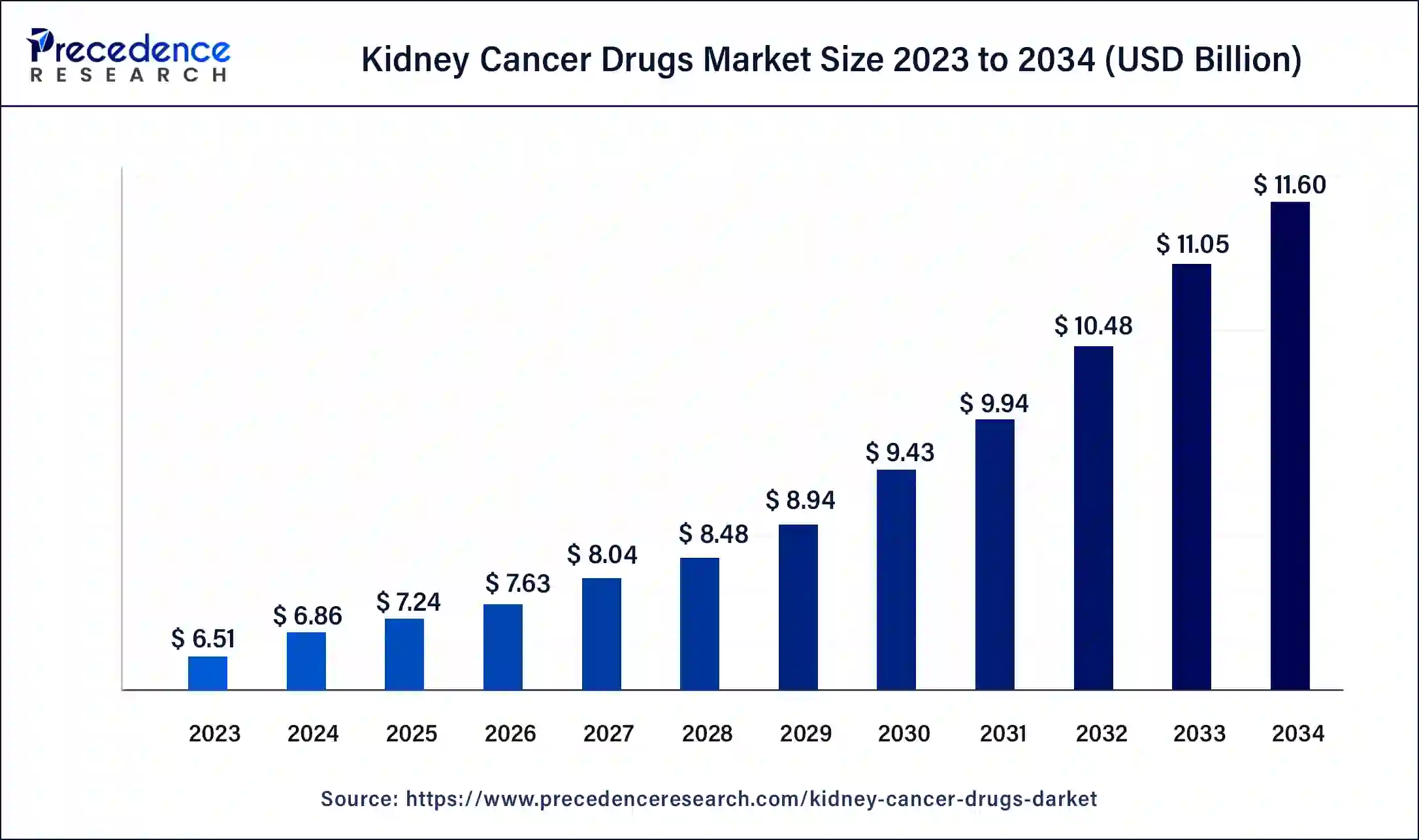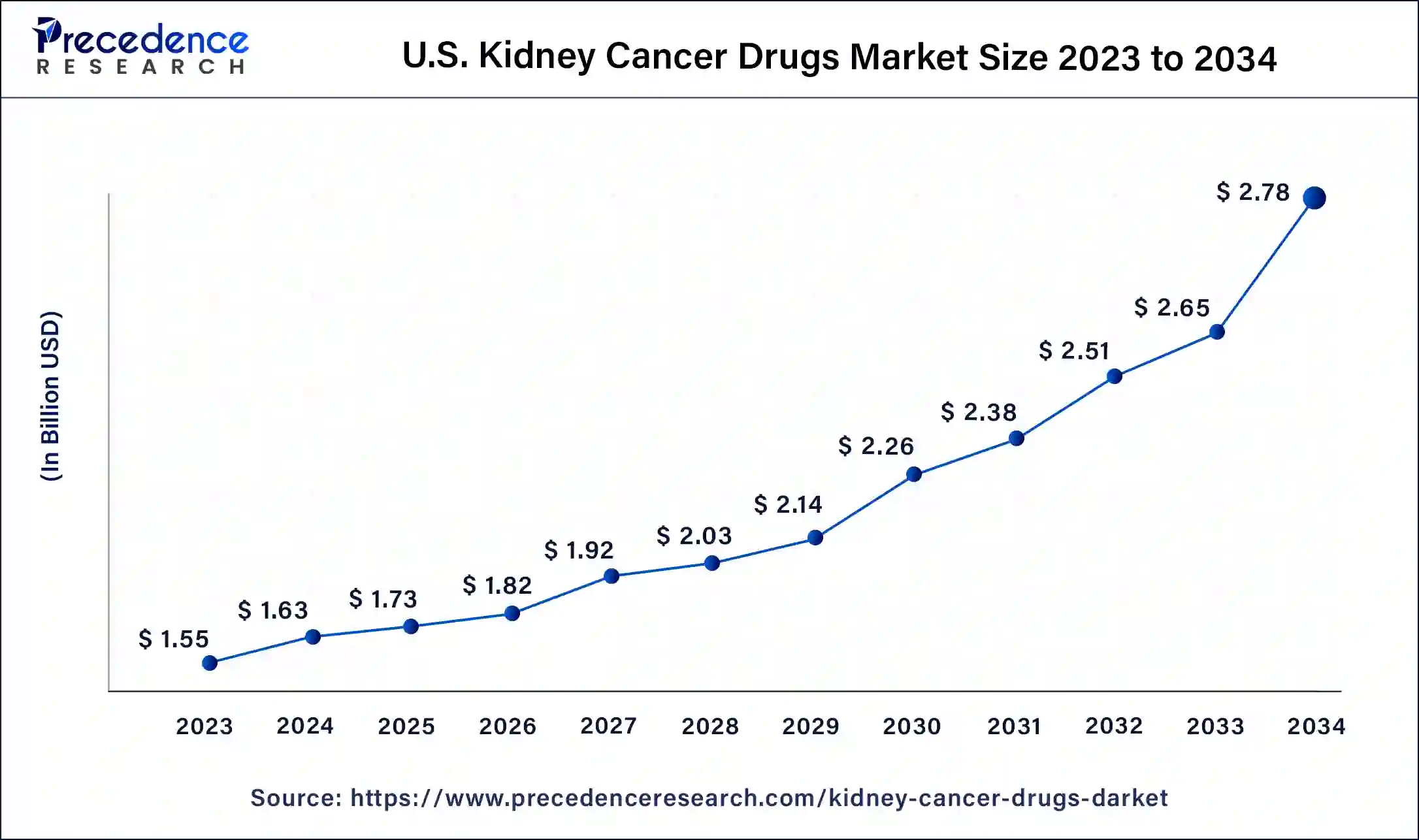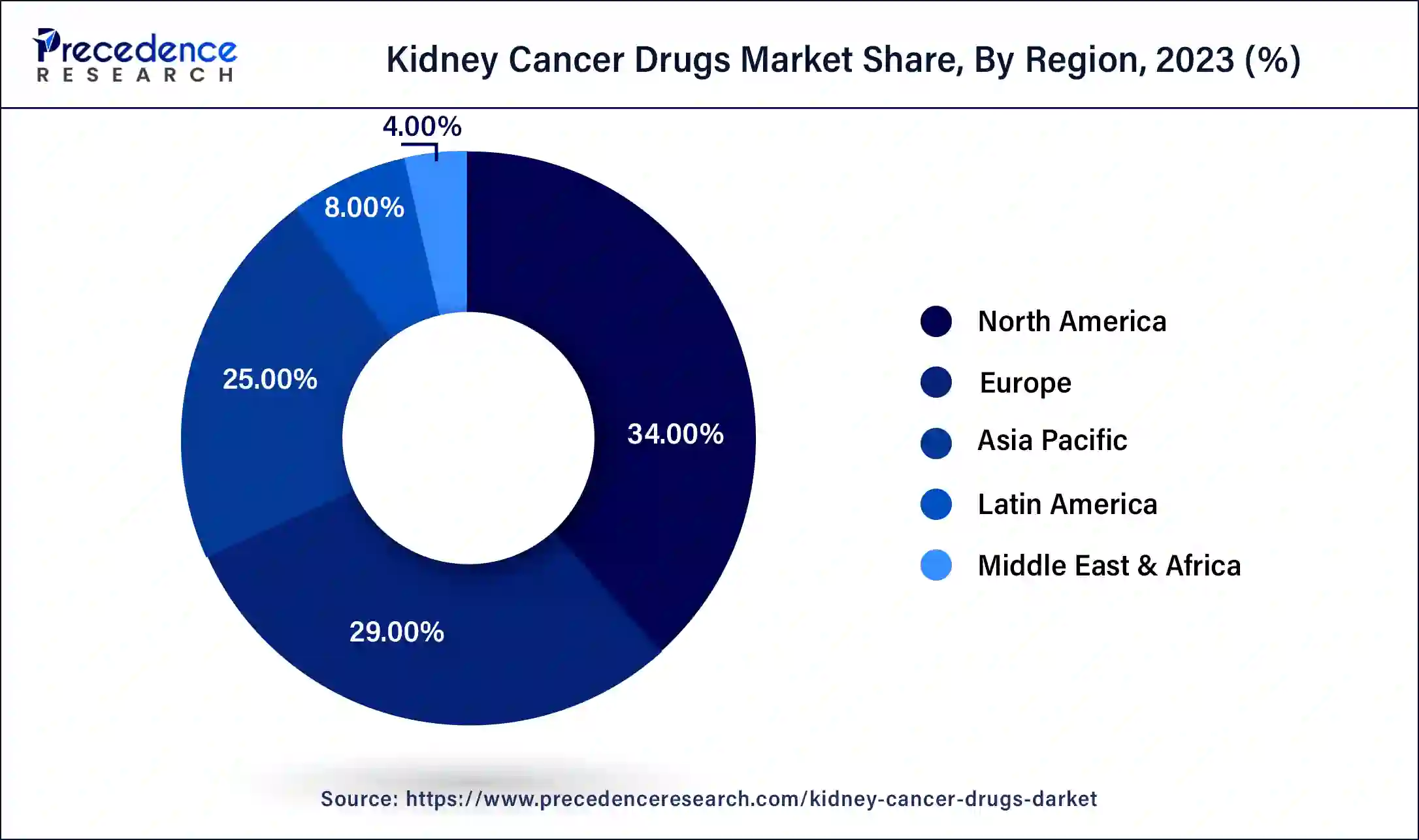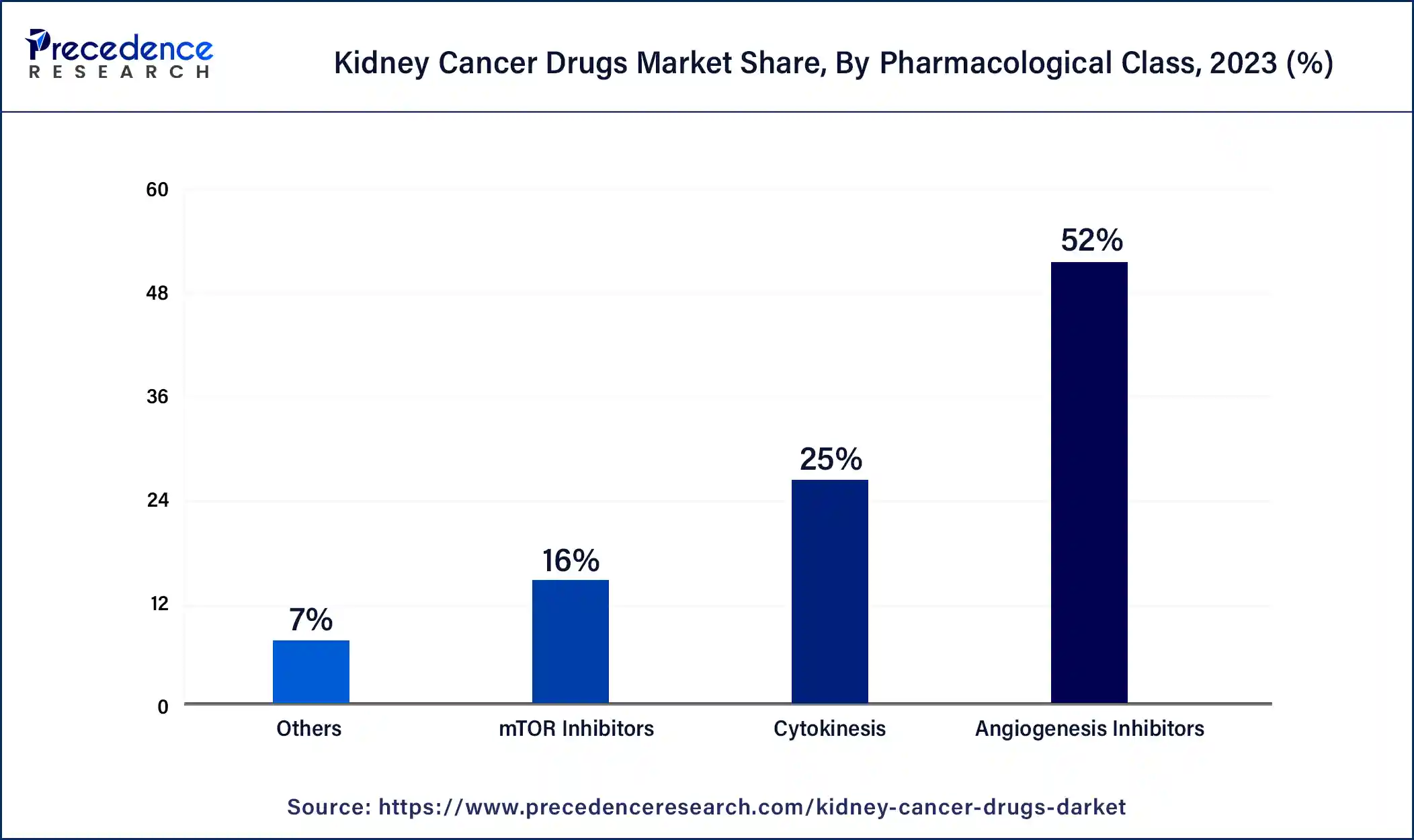January 2025
The global kidney cancer drugs market size was USD 6.51 billion in 2023, estimated at USD 6.86 billion in 2024 and is anticipated to reach around USD 11.60 billion by 2034, expanding at a CAGR of 5.39% from 2024 to 2034.
The global kidney cancer drugs market size accounted for USD 6.86 billion in 2024 and is predicted to reach around USD 11.60 billion by 2034, growing at a CAGR of 5.39% from 2024 to 2034. The North America reprocessed kidney cancer drugs market size reached USD 2.21 billion in 2023. Targeted therapy drugs, immunotherapy drugs, and chemotherapy drugs can help with the treatment of kidney cancers and contribute to the growth of the kidney cancer drugs market.

The U.S. kidney cancer drugs market size was estimated at USD 1.55 billion in 2023 and is predicted to be worth around USD 2.78 billion by 2034 with a CAGR of 5.48% from 2024 to 2034.

North America dominated the kidney cancer drugs market in 2023. Rising genetic disorders and the presence of healthcare facilities help to the growth of the market in the North American region. The United States is the leading country in the region in terms of the growth of the market for the treatment of kidney cancer.

Asia Pacific is estimated to hold the fastest-growing kidney cancer drugs market over the forecast period of 2024-2033. The diabetic population, hypertension, and high smoking lead to the growth of kidney cancers, and the increasing number of major key manufacturers of the products contribute to the growth of the market. China, India, and Japan are the leading countries in the region for the growth of the market.
The kidney cancer drugs market consists of sales of kidney cancer drugs and related services by entities such as organizations, sole traders, and partnerships that produce kidney cancer drugs to diagnose and treat kidney cancer. These industries include the formation of the drugs used in targeted therapy, immunotherapy, and chemotherapy.
Kidney cancer disease is caused by the cancerous or malignant cells in the kidney. This causes extreme fever and fatigue, sudden weight loss, low back pain, lump in the abdomen, and blood in urine. These various types can be life-threatening or dangerous if untreated. There is a need for drugs for the treatment of kidney cancer. Most of the doctors prescribe medications called immunotherapy and targeted therapy. Kidney cancer drugs help the body’s immune system to eliminate and recognize cancer cells. These factors help to the growth of the kidney cancer drugs market.
| Report Coverage | Details |
| Growth Rate from 2024 to 2034 | CAGR of 5.39% |
| Market Size in 2023 | USD 6.51 Billion |
| Market Size in 2024 | USD 6.86 Billion |
| Market Size by 2034 | USD 11.60 Billion |
| Largest Market | North America |
| Base Year | 2023 |
| Forecast Period | 2024 to 2034 |
| Segments Covered | Therapy Type, Pharmacological Class Type, Distribution Channel, and Regions |
| Regions Covered | North America, Europe, Asia-Pacific, Latin America, and Middle East & Africa |
Increasing senior population
As age increases, the risk of kidney cancer increases in the senior population or older age. Kidney cancer is found in the senior population more than the other. The senior population is exposed to chemicals, cigarette smoke, and sunlight, and their body can cause cancer agents instantly. Kidney cancer is more common in the senior population. This kidney cancer needs treatment with different drugs used in the therapies. This helps to the growth of the kidney cancer drugs market.
Increased risks of kidney cancer
Smoking people are the main reason for the risk of kidney cancer than the non-smoking person. People who are obese have higher risks of kidney cancer. Hypertension or high blood pressure increases kidney cancer risks. The treatment of kidney failure needs long-term dialysis, which has a high risk of kidney cancer developing. Mutation in DNA. Some people are born with specific inherited syndromes, which leads to risks of kidney cancer diseases. These risks of kidney cancer need kidney cancer drugs to treat kidney cancer. These factors help the growth of the kidney cancer drugs market.
Side effects of kidney cancer drugs
Side effects of the kidney cancer drugs include a careful balancing act, psychological distress, blisters on the soles of the feet and palms of the hand, skin rash, easy blooding or bruising because of the low blood platelet counts, increased chance of infections because of the low white blood cell counts, hair loss, swelling in legs or arms, high blood pressure, weight loss, mouth sores, nausea and vomiting, loss of appetite, muscle or joint pain, fatigue, and diarrhea. All kidney cancer patients face the problem of psychological burden with the life-threatening disease. These side effect factors of the kidney cancer drugs can restrict the growth of the kidney cancer drugs market.
Advanced technologies
Advancements in immunotherapy include the combination of drugs with one another or with kidney cancer drugs or medications for the treatment of kidney cancer. Advancements in kidney cancer biomarkers and tumor profiling biomarkers for cancer characteristics help to solve the issue. Kidney subtyping and biomarkers may also help to improve the science of the therapies, including immunotherapy for kidney cancer. Advancements in immunotherapy enhance the ability of the immune system to attack cancer cells. Immunotherapy can work in different ways based on the cells that are acting on the body. These advanced technology factors help the growth of the kidney cancer drugs market.
The targeted therapy segment dominated the kidney cancer drugs market in 2023. Kidney cancer can be treated by targeted therapy, which uses drugs to block certain proteins, genes, or molecules that fuel the growth of kidney tumors. The main two types of targeted therapy drugs are used for the treatment of kidney cancer, including monoclonal antibodies and tyrosine kinase inhibitors. Targeted therapy is more effective than the chemotherapy and immunotherapy. Most of the drugs used in the targeted therapy for the treatment of kidney cancer are angiogenesis inhibitors that disrupt the process of creating tumors by their blood vessels. These targeted therapy drugs are normally taken as tablets daily.
It also may be taken in combination with immunotherapy drugs for advanced kidney cancer as the first treatment. Targeted therapy drugs may help to treat advanced kidney cancers by slowing down or shrinking the growth of the cancer. Targeted therapy drugs can control or kill kidney cancer cells, and they help to relieve pain and control advanced kidney cancer symptoms. These factors help to the growth of the targeted therapy type segment and contribute to the growth of the market.
The immunotherapy segment is expected to witness the fastest growth in the kidney cancer drugs market during the forecast period. In the treatment of kidney cancer, immunotherapy is used to help the immune system fight off abnormal cells. The main types of immunotherapies for the treatment of kidney cancer include cytokinesis and immune checkpoint inhibitors. Immunotherapy can also be used in the treatment of advanced kidney cancer. This immunotherapy drug helps to recognize and destroy cancer cells more effectively. These factors help the growth of the immunotherapy-type segment and contribute to the growth of the market.
The angiogenesis inhibitors segment dominated the kidney cancer drugs market in 2023. For the treatment of kidney cancer drugs, angiogenesis inhibitors, including bevacizumab, axitinib, sorafenib, pazopanib, and sunitinib, are used. Some angiogenesis inhibitors are immunomodulatory drugs that suppress or stimulate the immune system, which have antiangiogenic characteristics. It helps improve overall and progression-free survival in patients who suffer from kidney cancer disease. These factors helped the growth of the angiogenesis inhibitors pharmacological class type segment and contributed to the growth of the market.

The cytokinesis segment will grow rapidly in the kidney cancer drugs market during the forecast period. Cytokinesis is used in immunotherapy to treat kidney cancer. Cytokinesis plays the main role in the anticancer immune response and is the main component of the immune system. These factors help the growth of the cytokinesis pharmacological class type segment and contribute to the growth of the market.
The hospital pharmacies segment dominated the kidney cancer drugs market in 2023. Hospital pharmacies have better access to patients' medical records. Improved discharge reconciliation and quality of admission by exercising oversight, a considerable contribution to safer medication use by cooperating with the other providers, offering information about possible side effects, and also checking the medicines are agreeable with existing medicines. Increased interaction with health professionals and prescribers helps to the growth of the market. Enhancing the reduction of readmission, continuity of care, and medication adherence. These factors help the growth of the hospital pharmacies distribution channel type segment and contribute to the growth of the market.
The retail pharmacies segment is projected to see the fastest growth during the forecast period. Retail pharmacies have direct access to pharmacists, which allows for personalized consultations by walk-in interactions with the pharmacists. Collaboration with the healthcare providers, and specialists, and contributing to the more comprehensive approach for patient care. It helps with one-stop shopping and saves time and effort. These factors help the growth of the retail pharmacies distribution channel type segment and contribute to the growth of the market.
Segments Covered in the Report
By Therapy Type
By Pharmacological Class Type
By Distribution Channel
By Geography
For inquiries regarding discounts, bulk purchases, or customization requests, please contact us at sales@precedenceresearch.com
No cookie-cutter, only authentic analysis – take the 1st step to become a Precedence Research client
January 2025
March 2025
January 2025
September 2024